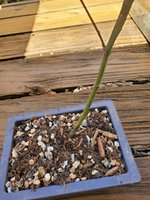FiggieSmalls
Yamadori
Hey folks,
So I've been growing my trees in gravel tubs as a buffer to the summer heat (to retain some moisture) and to insulate from the cold in winter. I just started 1 yr ago and so this is my first year of transition from winter to spring. We've had lots of rain and mild temps, leading me to wonder if I need to take measures to let my plants dry out better (since I can't stop the rain!). Now I'm starting to think yes...
I noticed this blackening at the base of one of my trees. Apparently it could be a fungus (vermicillium wilt). And I did notice at least one other tree in the same gravel tub that could be suffering the same condition.
I've read now that there is no known treatment for this pathogen, but now I'm wondering what to do about the situation in general. Should I quarantine the sick trees somehow? Should I throw out all the gravel in these bins (and any soil from sick trees)...? I'd prefer to recycle the material, but it is what it is.
As for treatment, right now I'm just thinking I will give them some earthworm castings and hope it will help them in their fight for survival. Not sure what else to do.
Should I buy some treatment for the rest of the plants, for use now and in the future? I don't love the idea of throwing harsh treatments at healthy plants year after year, but I don't trust myself to maintain diligent sanitary practices either, as far as cleaning tools between every cut etc...
Thanks all!
Figgie
So I've been growing my trees in gravel tubs as a buffer to the summer heat (to retain some moisture) and to insulate from the cold in winter. I just started 1 yr ago and so this is my first year of transition from winter to spring. We've had lots of rain and mild temps, leading me to wonder if I need to take measures to let my plants dry out better (since I can't stop the rain!). Now I'm starting to think yes...
I noticed this blackening at the base of one of my trees. Apparently it could be a fungus (vermicillium wilt). And I did notice at least one other tree in the same gravel tub that could be suffering the same condition.
I've read now that there is no known treatment for this pathogen, but now I'm wondering what to do about the situation in general. Should I quarantine the sick trees somehow? Should I throw out all the gravel in these bins (and any soil from sick trees)...? I'd prefer to recycle the material, but it is what it is.
As for treatment, right now I'm just thinking I will give them some earthworm castings and hope it will help them in their fight for survival. Not sure what else to do.
Should I buy some treatment for the rest of the plants, for use now and in the future? I don't love the idea of throwing harsh treatments at healthy plants year after year, but I don't trust myself to maintain diligent sanitary practices either, as far as cleaning tools between every cut etc...
Thanks all!
Figgie


